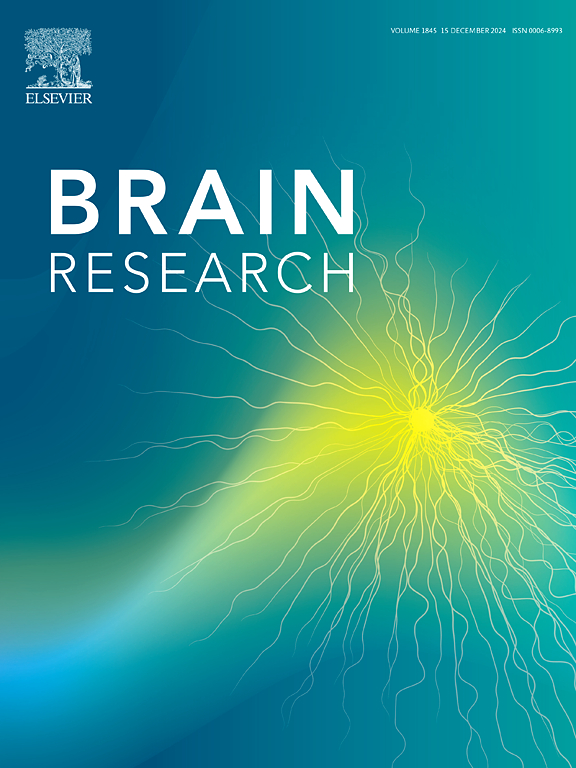HIIT may ameliorate inter-organ crosstalk between liver and hypothalamus of HFD-induced MAFLD rats; A two-phase study to investigate the effect of exercise intensity as a stressor
IF 2.7
4区 医学
Q3 NEUROSCIENCES
引用次数: 0
Abstract
Previous studies demonstrate that GDF15 and its related signaling activators may be affected by exercise training, leading to the suppression of inflammatory factors and the promotion of immune-metabolic balance. Therefore, the purpose of the study was to evaluate the effect of high-intensity interval training (HIIT) on amelioration of inter-organ crosstalk between liver and hypothalamus of the high-fat diet (HFD)-induced metabolic dysfunction-associated fatty liver disease (MAFLD) rats in a two-phase study. In this regard, rats were initially divided into two groups, the normal diet-inactive (NS) and the HFD groups. HFD course lasted 12 weeks to induce MAFLD in the latter group. After ensuring the induction of MAFLD, 25 rats were divided into three groups: the HFD-inactive group (HS), the HFD-HIIT group (HH), as well as the HFD-aerobic group (HA). The training interventions were consistently applied over a period of eight weeks, five days a week, with each session lasting 40–60 min, and the duration of the whole research was 21 weeks. The results of this study displayed that HIIT intervention promotes hypothalamic Gdf15 gene expression and there were similar alterations in genes expression of Foxo1 and Akt2. Moreover, our results confirmed that HIIT ameliorated hypothalamic NFKB gene expression and there was a similar trend in genes expression of Tnfa and Il1b following both HIIT as well as aerobic training protocols. Taking these findings together, it is concluded that interventions, particularly exercise training, uniquely contribute to the reduction of hypothalamic-associated inflammatory responses that result in prolonged and chronic increases in GDF15.

HIIT可改善hfd诱导的mald大鼠肝脏与下丘脑间的器官间串扰;一项两阶段的研究,旨在调查运动强度作为应激源的影响
既往研究表明,运动训练可能会影响GDF15及其相关信号激活因子,从而抑制炎症因子,促进免疫代谢平衡。因此,本研究的目的是通过两期研究来评估高强度间歇训练(HIIT)对高脂肪饮食(HFD)诱导的代谢功能障碍相关脂肪肝(MAFLD)大鼠肝脏和下丘脑器官间串扰的改善作用。在这方面,大鼠最初分为两组,正常饮食不活跃(NS)组和HFD组。HFD疗程持续12周,以诱导MAFLD。在确保MAFLD诱导后,将25只大鼠分为三组:HFD-inactive组(HS)、HFD-HIIT组(HH)和hfd -有氧组(HA)。训练干预持续了八周,每周五天,每次持续40-60分钟,整个研究持续了21周。本研究结果显示,HIIT干预促进下丘脑Gdf15基因表达,Foxo1和Akt2基因表达也有类似的改变。此外,我们的研究结果证实,HIIT改善了下丘脑NFKB基因的表达,并且在HIIT和有氧训练方案中,Tnfa和Il1b的基因表达也有类似的趋势。综合这些研究结果,我们得出结论,干预措施,特别是运动训练,对减少下丘脑相关的炎症反应有独特的贡献,这些炎症反应导致GDF15的长期和慢性增加。
本文章由计算机程序翻译,如有差异,请以英文原文为准。
求助全文
约1分钟内获得全文
求助全文
来源期刊

Brain Research
医学-神经科学
CiteScore
5.90
自引率
3.40%
发文量
268
审稿时长
47 days
期刊介绍:
An international multidisciplinary journal devoted to fundamental research in the brain sciences.
Brain Research publishes papers reporting interdisciplinary investigations of nervous system structure and function that are of general interest to the international community of neuroscientists. As is evident from the journals name, its scope is broad, ranging from cellular and molecular studies through systems neuroscience, cognition and disease. Invited reviews are also published; suggestions for and inquiries about potential reviews are welcomed.
With the appearance of the final issue of the 2011 subscription, Vol. 67/1-2 (24 June 2011), Brain Research Reviews has ceased publication as a distinct journal separate from Brain Research. Review articles accepted for Brain Research are now published in that journal.
 求助内容:
求助内容: 应助结果提醒方式:
应助结果提醒方式:


